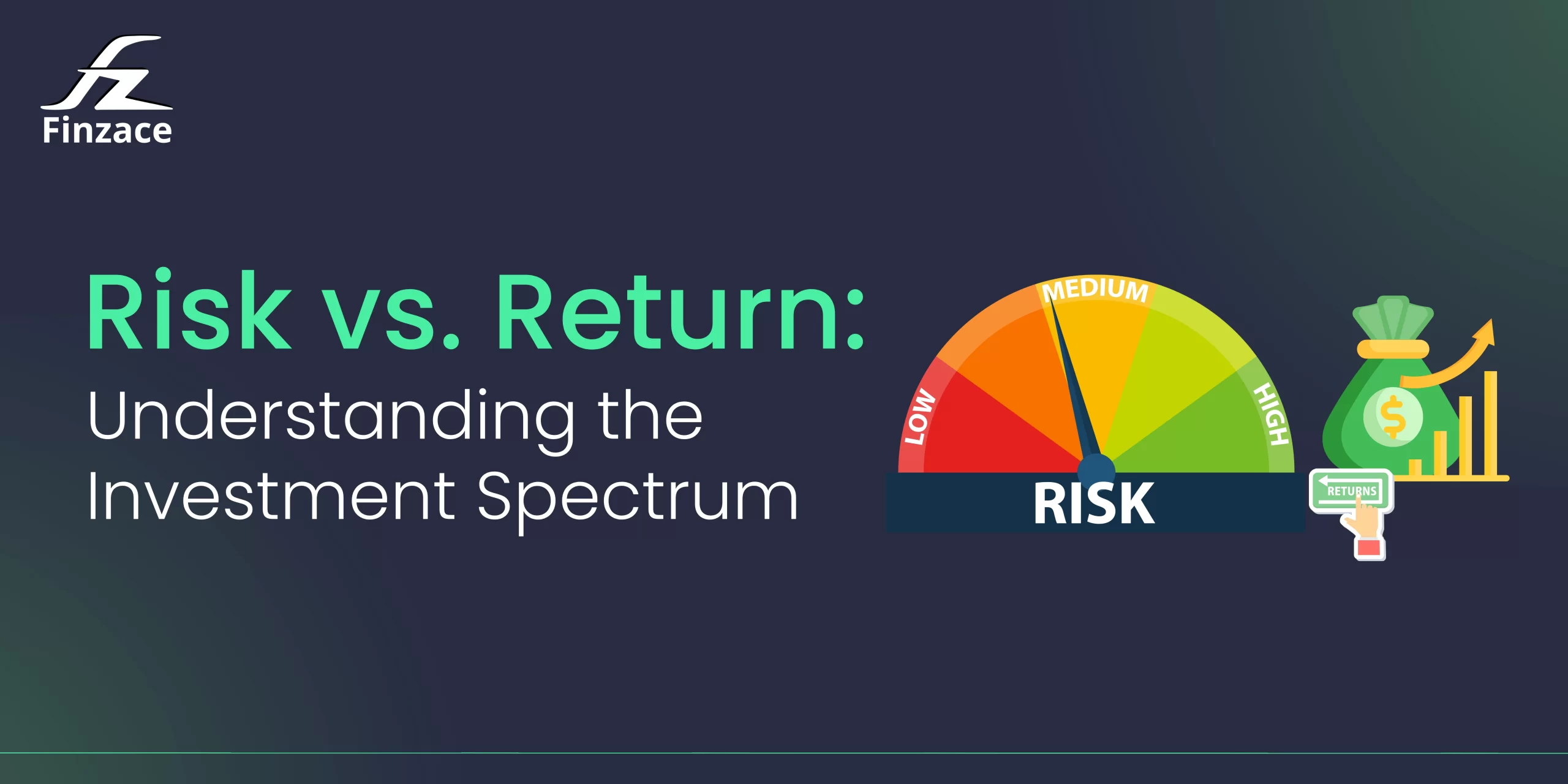Risk vs. Return: Understanding the Investment Spectrum

In the dynamic world of personal finance, one principle remains constant: the relationship between risk and return. As an investor, understanding this fundamental concept is crucial to building a portfolio that aligns with your financial goals and comfort level. Whether you’re just starting your investment journey or looking to refine your strategy, this comprehensive guide from Finzace will help you navigate the risk-return spectrum with confidence.
The Risk-Return Tradeoff: The Foundation of Investment Strategy
The risk-return relationship is straightforward in theory but nuanced in practice: investments with higher potential returns typically come with higher risks. This correlation is not just financial theory—it’s an essential market reality that shapes every investment decision.
When you invest your hard-earned money, you’re essentially being compensated for taking on risk. The market rewards those willing to embrace uncertainty with the potential for greater returns. This fundamental principle explains why a savings account offers minimal returns with virtually no risk, while equity investments can deliver substantial growth but with significant volatility.
Why This Matters to You
Your investment success largely depends on finding the right balance between risk and return that aligns with your:
- Financial goals
- Time horizon
- Personal risk tolerance
- Current life stage
The Investment Risk Spectrum: From Safe Havens to High-Risk Opportunities
Low-Risk Investments: Safety First
At the conservative end of the spectrum, you’ll find investments focused on capital preservation rather than aggressive growth.
Fixed Deposits (FDs): These remain one of India’s most popular investment vehicles due to their simplicity and safety. With major banks offering rates between 5.75% to 7.25% for regular citizens and an additional 0.50% for senior citizens, FDs provide predictable returns with minimal risk. Finzace’s FD marketplace allows investors to compare rates across institutions and invest directly without visiting multiple banks, making it easier to find the best rates for your needs.
Key characteristics of low-risk investments include:
- Predictable returns
- Capital protection
- Government or institutional backing
- Liquidity (in many cases)
- Lower returns compared to riskier assets
Other Low-Risk Options:
- Government securities like Treasury Bills
- Savings accounts
- Money market funds
- Public Provident Fund (PPF)
Medium-Risk Investments: Balancing Growth and Stability
Medium-risk investments strike a balance between growth potential and downside protection.
Corporate Bonds: These debt securities issued by companies typically offer higher yields than government bonds (between 7.5% and 8.5% for AAA-rated bonds) to compensate for the additional risk. They represent a middle ground where investors can enhance returns without taking on excessive volatility. Finzace has democratized access to corporate bonds with minimum investments starting at ₹10,000, significantly lower than the traditional threshold of ₹1 lakh or more.
Other Medium-Risk Options:
- Balanced mutual funds
- Real Estate Investment Trusts (REITs)
- Blue-chip dividend stocks
- Index funds
High-Risk Investments: Seeking Growth
For those with longer time horizons and higher risk tolerance, these investments offer the greatest growth potential but also the most volatility.
Equity Investments: Direct stock investments have historically delivered superior long-term returns compared to other asset classes, despite short-term volatility. The Indian stock market has shown remarkable resilience, with the Nifty 50 delivering annualized returns of approximately 13% over the past decade.
Other High-Risk Options:
- Small-cap stocks
- Sector-specific funds
- International equities
- P2P lending
- Cryptocurrency (with appropriate caution)
- Startup investments
Understanding Your Risk Tolerance: The Personal Factor
Your risk tolerance is a deeply personal aspect of investing that depends on both financial and psychological factors.
Financial Factors Affecting Risk Tolerance
- Age and time horizon
- Income stability
- Existing assets and liabilities
- Financial responsibilities
- Emergency fund adequacy
Psychological Factors
- Comfort with uncertainty
- Emotional response to market fluctuations
- Sleep factor (can you sleep well at night with your investments?)
- Financial knowledge and confidence
Crafting a Risk-Appropriate Portfolio
The most successful investment strategy is one that aligns with your risk tolerance while working toward your financial goals.
Asset Allocation Models Based on Risk Profile
Conservative Portfolio (Low Risk):
- 20-30% Equity
- 50-60% Fixed Income
- 10% Gold
- 5-10% Real Estate
- 0-5% Alternatives
Moderate Portfolio (Medium Risk):
- 40-50% Equity
- 30-40% Fixed Income
- 10% Gold
- 5-10% Real Estate
- 5-10% Alternatives
Aggressive Portfolio (High Risk):
- 60-70% Equity
- 15-25% Fixed Income
- 5% Gold
- 5-10% Real Estate
- 5-15% Alternatives
Risk Management Strategies for Every Investor
Understanding risk is just the beginning—managing it effectively is what separates successful investors from the rest.
Diversification: Your First Line of Defense
Diversification remains one of the most powerful risk management tools available to investors. By spreading investments across different asset classes, sectors, geographies, and time periods, you can reduce the impact of poor performance in any single area.
Effective diversification includes:
- Asset class diversification (stocks, bonds, gold, real estate)
- Geographical diversification (domestic and international markets)
- Sector diversification (avoiding overconcentration in specific industries)
- Temporal diversification (staggered investments over time, such as SIPs)
Other Essential Risk Management Techniques
Emergency Fund: Before venturing into market-linked investments, maintain 6-12 months of expenses in highly liquid instruments to avoid forced liquidation during personal financial emergencies.
Regular Rebalancing: Periodically adjust your portfolio back to target allocations, typically semi-annually or when allocations deviate by 5% or more.
Dollar-Cost Averaging: Invest fixed amounts at regular intervals to reduce the impact of market timing and volatility.
Laddering Strategy: For fixed income investments, create maturity ladders to manage interest rate risk and liquidity needs.
The Role of Digital Gold in Risk Diversification
Gold has traditionally served as a hedge against inflation and market volatility. Digital gold offers modern investors a convenient way to include this protective asset in their portfolios.
Finzace Gold has gained significant market share by offering among the lowest storage fees (0.5% annually) and transparent buyback rates. Investors can purchase gold in small amounts (as low as ₹10) with guaranteed 99.9% purity and no storage worries. What sets Finzace Gold apart is its unique feature that allows investors to convert their digital gold holdings into gold ETFs or Sovereign Gold Bonds during issuance windows.
Digital gold has delivered annualized returns of approximately 10.8% over the past 5 years, providing both growth and portfolio stabilization during market turbulence.
How Market Cycles Affect the Risk-Return Equation
Market cycles introduce another dimension to the risk-return relationship. During bull markets, even high-risk investments may seem deceptively safe as everything rises. Conversely, bear markets can temporarily reduce returns across the board.
Understanding where we are in the economic cycle can help investors make strategic adjustments to their risk exposure:
- Expansion phase: Consider gradually increasing equity exposure
- Peak: Consider taking some profits and becoming more defensive
- Contraction: Focus on quality and consider increasing fixed income allocation
- Trough: Begin looking for value opportunities while maintaining safety
The Behavioral Aspects of Risk
Our perception of risk is often influenced by cognitive biases that can lead to suboptimal investment decisions:
Recency Bias: Giving too much weight to recent events while neglecting longer-term patterns Loss Aversion: Feeling the pain of losses more acutely than the pleasure of equivalent gains Herd Mentality: Following what others are doing rather than adhering to your own strategy Overconfidence: Overestimating your ability to predict market movements
Recognizing these biases is the first step toward making more rational investment decisions. Consider keeping an investment journal to track your decision-making process and emotional responses to market events.
Adjusting Risk Exposure Through Life Stages
Your optimal risk profile naturally evolves as you progress through different life stages:
Early Career (20-35 years)
- Higher equity allocation (60-80%)
- Focus on growth over stability
- Higher risk tolerance due to long recovery time
- Finzace’s simplified platform makes it easier for young investors to begin their journey with accessible minimums
Mid-Career (35-50 years)
- Balanced approach (40-60% equity)
- Increasing fixed income component
- Strategic tax planning becomes crucial
- Consider Finzace’s tax calculators to see actual post-tax returns for comparison across instruments
Pre-Retirement (50-60 years)
- Capital preservation gains importance
- Fixed income increases to 50-60%
- Focus on dividend-generating equities
- Finzace’s bond marketplace offers easier access to higher-yielding corporate bonds for income
Retirement (60+ years)
- Income generation is primary
- Capital preservation is critical
- Fixed income dominates (60-70%)
- Senior citizens can benefit from Finzace’s curated selection of special senior citizen FD rates
Conclusion: Finding Your Personal Risk-Return Balance
The investment journey is uniquely personal. There’s no one-size-fits-all approach to managing the risk-return tradeoff. The most successful investors are those who understand their own risk tolerance, set realistic expectations for returns, and maintain discipline through market cycles.
By aligning your investment strategy with both your financial goals and your comfort with risk, you can build a portfolio that helps you sleep well at night while still working toward your long-term objectives. Remember that investment success isn’t measured by how much risk you take, but by how effectively you manage risk to achieve your financial goals.
With Finzace’s comprehensive suite of investment products spanning the risk spectrum—from fixed deposits and bonds to digital gold—investors can build a well-diversified portfolio that matches their unique risk profile and financial goals.
Ready to put your understanding of risk and return into practice? Explore the comprehensive guide to investment options in India for 2025 to find the right mix of investments for your risk profile, or visit Finzace’s platform to start building your balanced portfolio today.
Disclaimer: The information provided in this guide is for educational purposes only and should not be construed as financial advice. Investment involves risks, and past performance is not indicative of future results. Readers are advised to consult with a qualified financial advisor before making investment decisions.


